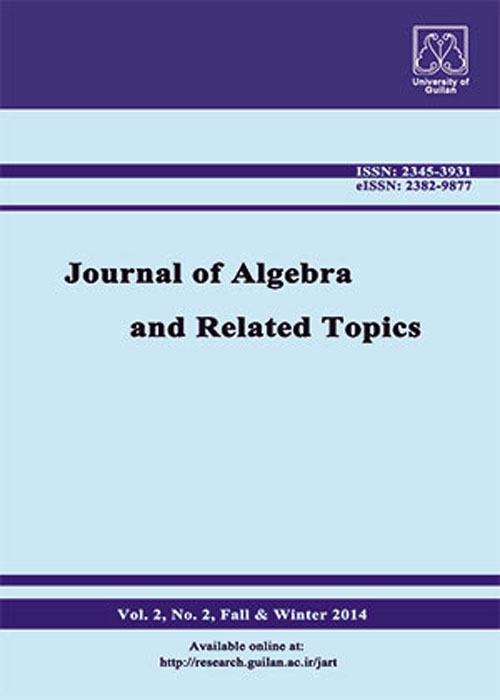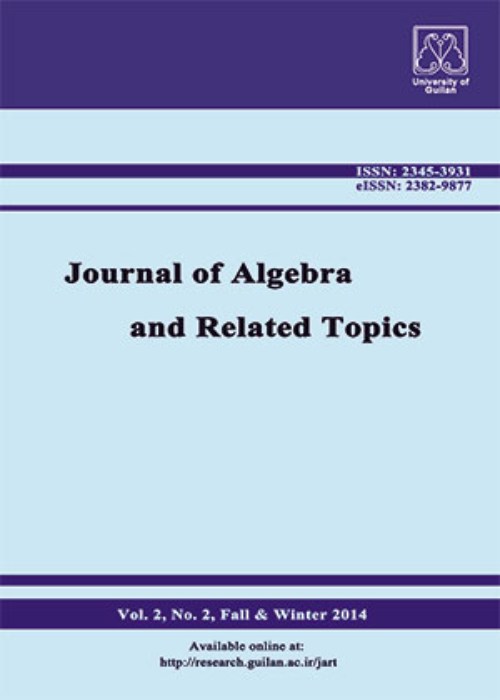فهرست مطالب

Journal of Algebra and Related Topics
Volume:6 Issue: 2, Autumn 2018
- تاریخ انتشار: 1397/09/05
- تعداد عناوین: 6
-
Pages 1-14Let $M$ be a lattice module over a $C$-lattice $L$. Let $Spec^{p}(M)$ be the collection of all prime elements of $M$. In this article, we consider a topology on $Spec^{p}(M)$, called the classical Zariski topology and investigate the topological properties of $Spec^{p}(M)$ and the algebraic properties of $M$. We investigate this topological space from the point of view of spectral spaces. By Hochster's characterization of a spectral space, we show that for each lattice module $M$ with finite spectrum, $Spec^{p}(M)$ is a spectral space. Also we introduce finer patch topology on $Spec^{p}(M)$ and we show that $Spec^{p}(M)$ with finer patch topology is a compact space and every irreducible closed subset of $Spec^{p}(M)$ (with classical Zariski topology) has a generic point and $Spec^{p}(M)$ is a spectral space, for a lattice module $M$ which has ascending chain condition on prime radical elements.Keywords: prime element, prime spectrum, classical Zariski topology, finer patch topology
-
Pages 15-33Let Xn={1,2,…,n} be a finite chain, ODPn be the semigroup of order-preserving partial isometries on Xn and N be the set of all nilpotents in ODPn. In this work, we study the nilpotents in ODPn and investigate the ranks of two subsemigroups of ODPn; the nilpotent generated
subsemigroup ⟨N⟩ and the subsemigroup ~L(n,r)={α∈ODPn:|im α|≤r}.Keywords: Order-Preserving partial transformations, isometries, height, right (left) waist, idempotents, nilpotents -
Pages 35-61The rings considered in this article are commutative with identity which admit at least one nonzero proper ideal. Let R be a ring. Let us denote the collection of all proper ideals of R by I(R) and I(R)∖{(0)} by I(R)∗. With R, we associate an undirected graph denoted by g(R), whose vertex set is I(R)∗ and distinct vertices I1,I2 are adjacent in g(R) if and only if I1∩I2≠I1I2. The aim of this article is to study the interplay between the graph-theoretic properties of g(R) and the ring-theoretic properties of R.Keywords: Artinian ring, Special principal ideal ring, diameter, girth, clique number
-
Pages 63-78First, we apply the method presented by Zahra Sepasdar in the two-dimensional case to construct a basis of a three dimensional cyclic code. We then generalize this construction to a general s-dimensional cyclic code.
KeywordsKeywords: quotient-ring, ideal, ideal basis, multicyclic code, polynomial division algorithm (by many divisors) -
Pages 79-96Let $mathcal{R}$ be a ring. For a quasi-bigraduation $f=I_{(p,q)}$of ${mathcal{R}} $ we define an $f^{+}-$quasi-bigraduation of an ${%mathcal{R}}$-module ${mathcal{M}}$ by a family $g=(G_{(m,n)})_{(m,n)inleft(mathbb{Z}times mathbb{Z}right) cup {infty }}$ of subgroups of $%{mathcal{M}}$ such that $G_{infty }=(0) $ and $I_{(p,q)}G_{(r,s)}subseteqG_{(p+r,q+s)},$ for all $(p,q)$ and all $(r,s)in left(mathbb{N} timesmathbb{N}right) cup {infty }.$ Here we show that $r$ elements of ${mathcal{R}}$ are $J-$independent oforder $k$ with respect to the $f^{+}$quasi-bigraduation $g$ if and only ifthe following two properties hold: they are $J-$independent of order $k$ with respect to the $^+$%quasi-bigraduation of ring $f_2(I_{(0,0)},I)$ and there exists a relation ofcompatibility between $g$ and $g_{I}$, where $I$ is the sub-$mathcal{A}-$%module of $mathcal{R}$ constructed by these elements. We also show that criteria of $J-$independence of compatiblequasi-bigraduations of module are given in terms of isomorphisms of gradedalgebras.Keywords: Quasi-bigraduations, modules, generalized analytic independence
-
Pages 97-106In this paper we show for a finitely generated module M over a Noetherian ring A any two regular prime extension filtration of M have same length. We call this length as prime extension dimension of M and denote it by pe.d A (M). This dimension measure how far a module is from torsion freeness of its zero submodule and this dimension is bounded above by length of a module. We show for every submodule N of M, pe.d A (N) ≤ pe.d A (M) and pe.d A (N) + pe.d A (M/N) ≥ pe.d A (M) and we give a characterization for computing prime extension dimension of M in terms of prime extension dimension of its minimal primary decomposition of the zero submodule.Keywords: Prime submodules, Primary decomposition, Prime filtration, Regular prime extension filtration


